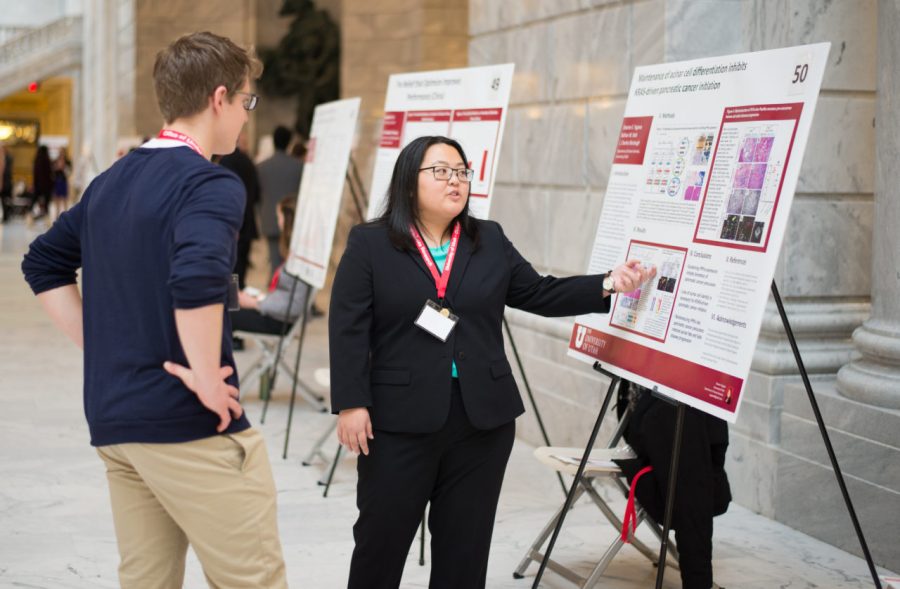U students gathered in the rotunda of the Utah State Capitol Tuesday morning to exhibit their research projects for the 17th annual Research Day on the Hill.
After spending months on research, students were eager to present their feats to local legislators and community members.
Mu Pye and Kai Sin
Both from a Karen Refugee village in Thailand, Mu Pye and Kai Sin presented their findings on heart disease among Utah refugees.
Their project is called Lifestyle Issues Related to Cardiovascular Disease Among Refugees in Utah.
“Many refugees have no health insurance,” Pye said.
Sin adds, “In Thailand there is no health promotion,” Sin said
“The children can’t leave the refugee camp and they have to spend their days working,” Sin said.
The students found that language barriers contribute to why refugees don’t seek medical attention.
“Many refugees do not seek out services that are provided to them,” said Sin. They are also “unable to use mass transit because they can’t speak English.”
Sin’s inspiration for spearheading this project comes from her own experiences as a refugee.
“I saw how things were in Thailand and it motivated me to look at the differences,” said Sin.
Both Pye and Sin were raised in low income families and are the first generation to graduate high school, and soon-to-be college.
“Many refugees don’t go to college and keep out of the public due to language barriers,” said Pye.
After presenting her first research project Pye feels compelled to inspire other students, regardless of socioeconomic status, to pursue undergrad research as well.
“At the beginning of the project I felt like ‘I can’t do this…because I’m just a refugee,'” said Pye. “Now, I feel like everybody can do research, even refugees.”
Abigail Neal
“I was looking for research opportunities and I met Dr. Park… he helped me get involved,” said Abigail Neal, a Neuroscience major who’s passionate about psychology, math and science. Dr. Albert Park, M.D. is a Professor in the Department of Surgery.
Neal’s project focuses on Comparing the Effectiveness, Safety and Cost of Anesthetic Choice Undergoing Drainage for Peritonsillar Abscess.
“It’s a retrospective study about using local anesthesia versus general anesthesia [during peritonsillar abscess procedures]; and comparing the effectiveness and costs,” she said. “Research was taken from looking at and comparing past medical records.”
Neal applied for the program because it’s such a great opportunity for her to show her accomplishments in research.
She offers this advice to fellow student’s who are interested in conducting research but are unsure of how to start — “Look into what you’re interested in and go from there.”
Timothy Allen
Timothy Allen, a physics major at the U, presented his research, Relating Shape to Color: A More Effective Way To Find the Colors of an Image. In other words: designing microscopes.
Allen explains that his research deals with the splitting of light beams and how different shapes create different dimensions in the light, forging clearer microscopic images.
“I’m really interested in politics. I wanted the chance to show my legislators what I’ve been involved in and what I’ve been working on throughout my college career,” Allen said. “I’m looking forward to meeting my legislators even just as a constituent.”
Allen suggests to his fellow students that are interested in presenting at Research on the Hill to explore options at Office of Undergraduate Research.
After writing a proposal and contacting a professor, Undergraduate Research offers students grants to conduct research.
“Professors are pretty nice, you just have to shoot them an email and let them know that you’re interested in their research. Find something that interests you,” Allen says.
Adam Whalen
Adam Whalen, a Senior majoring in Communications, spent his summer months involved in the iFellows program where he engaged in different research prior to tackling undergraduate research at the U. His Research on the Hill project is called, A Comparative Analysis on Attitudes Toward Drinking Water Quality Between Utah and the Nation; which was funded by the National Science Foundation.
Whalen collected data by posing a simple question to the public about their perceived attitude toward drinking water in Utah. He conducted a comparative analysis between the public’s attitudes towards drinking water and how Utah stacks up to the rest of the nation.
“The biggest take away I want people to get from my research is awareness on the issue,” says Whalen.
An observation that he discovered while conducting research is that females in Utah perceive the drinking water to be worse than men do.
“One and a half years ago, I was in my Quantitative Research class when I was approached by my professor and she guided me through the process,” Whalen says.
Professor Sarak Yeo is an Assistant Professor for the Department of Communication. She and Whalen worked collaboratively on the completion of this project.
According to Whalen, Professor Yeo told him, “there’s a really cool opportunity that I want you to apply for,” and he was on board.
Advice from Whalen for his fellow students who are interested in Research on the Hill: “I showed up to class and I was involved in the class,” says Whalen. “I raised my hand often and asked questions and participated in the lectures.”
As for Whalen’s secret to success; he says yes to every opportunity that presents itself to him.
a.baker@dailyutahchronicle.com



Danielbaw • Mar 16, 2017 at 1:13 pm
Free sample edit for virtually any document.
Writing methodology for dissertation dissertation topic hiv aids bangladesh Essay writing 5 paragraph global warming essays conclusion Dissertation methodology write up paper about responsibility Essay about my mother how to do a research